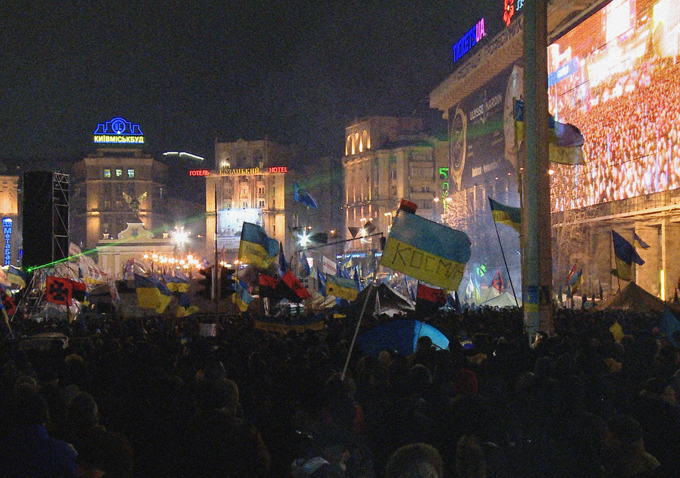
Sergei Loznitsa is no stranger to Cannes, both of his previous features competing for the Palme d’Or with 2012’s “In The Fog” winning the critics’ FIPRESCI prize. So when news went around that he’s making a documentary on the Ukrainian protests, there was only one place for it to premiere. “Maidan” is a study of a people under stress, a spirit hindered by totalitarianism, and the grasping of patriotic straws with the last God-given strength a nation has. The trouble with the picture is that it’s barren of cinematic context; the camera doesn’t so much as tilt or pan, remaining irrevocably fixed and observing straight ahead.
Because of this, our patience was tested more than it has been with any other picture at this year’s festival (and it’s worth pointing out, we’ve never seen as many walkouts as we did at this screening). This still doesn’t take away from the glaring importance of Loznitsa’s meditative scrutiny. The educational, political, and sociological implications suggested by the existence of “Maidan” will echo for some time to come, and are categorically vital. All you have to do is to keep your head from dropping.
As this is a plotless documentary, without even the convenience of talking heads to talk us away from stagnation, it’s a little tough to summarize a narrative. Any reoccurring motifs or themes that are created by witnessing these protests belong to the people of Ukraine, not Sergei Loznitsa. This is, of course, the whole point. During his introduction, Loznitsa said “I give you Maidan. I give you: Ukraine.” Anyone who walked in expecting a clearer focal point than that were presumably among the first to walk out. Nevertheless, camera positioning is still a crucial element here, and something that Loznitsa paid close attention to.

The very first shot is a sea of people that fills up every inch of the frame, singing Ukraine’s national anthem. The faces are themselves miniature portraits of a drained nation, something anyone who has traveled anywhere in the Eastern parts of Europe is all too familiar with. However, thanks to Loznitsa’s frozen camera and uncut scenes that last for well over 10 minutes, the eye is left to wander from face to face and notice one or two expressions which still suggest belief, hope, and an unwavering love for one’s country. It’s in this powerful way we begin proceedings in “Maidan” as people shout out “Glory!” in a chant of loyalty and sing about the spirit, God, and fraternity.
Once your eye finds the woman close to the middle of the frame, her conviction is potent enough to produce goosebumps. Then you are reminded by the toll endured by others when you find an older man with barely enough energy to move his lips. It’s as naturally effective as cinema gets because this is as naked as it gets; “based on a true story” doesn’t need to be written on any title cards here, it’s obvious on every dejected and hopeful face alike.
If there is any reoccurring theme, it’s the national anthem. A few scenes after the opening, the camera points to a crowded alley and a guitar player asks the camera operator if playing the anthem would be OK. As soon as he does, a few people standing by immediately join in and it’s the kind of moment which can move the most unpatriotic among us. Even when it’s not being sung, the words of the anthem get reenacted through events Loznitsa’s camera makes sure to capture. A long queue of people waiting in line for soup, a priest speaking to a crowd of thousands about the importance of standing together, a young boy looking for his brother who has been lost in the crowd. Just a few touching examples of how the national anthem is in many ways the lead character of this story, even when it’s not blasting through the speakers.
These moments of brotherhood are balanced out against evidence of state violence against their own, the people they are claiming to love and protect. Scenes of unquenchable fires, armies of shielded soldiers, and fired up mobs are unwaveringly observed and effectively depict the broken threads of the current state of affairs in Ukraine. The closest thing to a narrative structure comes in the form of title cards telling us about the dividing conflict and how Ukraine’s integration into Europe and away from Russia, marking certain event like marches to parliament with dates and short descriptions, describing what Maidan is exactly, and explaining the state’s reactions. It’s in this way we find out that Loznitsa was using footage all the way up to March of this year, a few months before Cannes, infusing the project with an immediacy that adds to the experience of being placed as witness to these events.
It’s a potent depiction of history in the now and open-heart surgery of a country in peril, which makes Maidan the most humanitarian film to come out of Cannes this year. If you have the patience to play the role of silent witness for the full two hours, Maidan is a rewarding experience and an alarmingly important wake-up call for those still in the dark about one of today’s most critical situations. [B+]
Browse through all our coverage of the 2014 Cannes Film Festival by clicking here.





